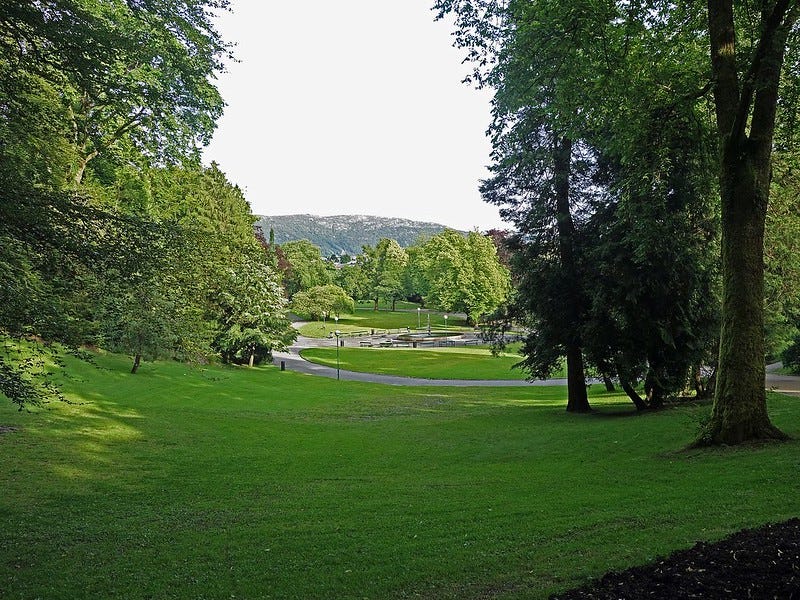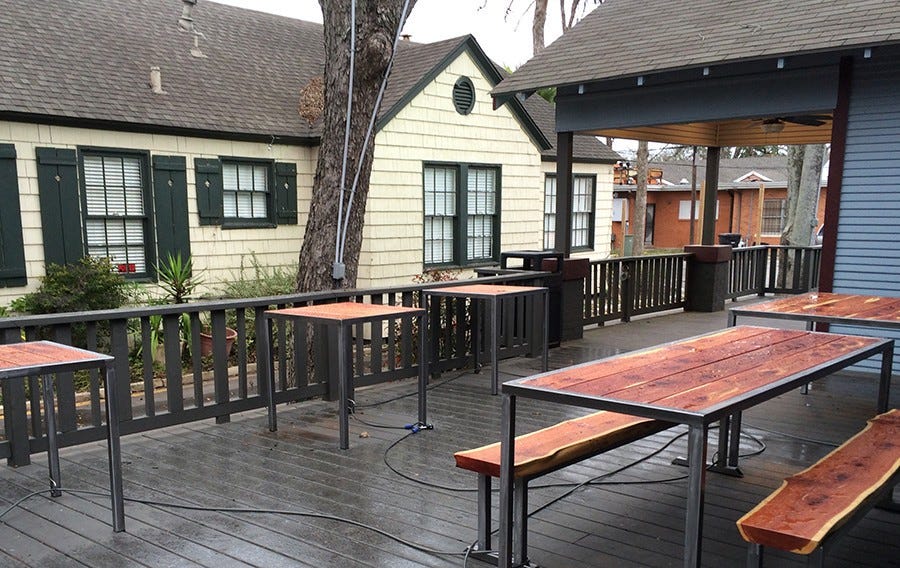👩🏻💻 A Reader Roundup of Favorite Public Spaces
We hope they spark inspiration and connectedness.
Last fall, we heard from our contributing editors about their favorite global public spaces, from street art in Johannesburg to beaches along the Los Angeles coastline. As readers of New_ Public, you are now accomplices in our movement — together in publicness. We wanted to share the knowledge that was shared with us via email as a collective offering, hoping to spark inspiration or connectedness amongst more people.
This week, we share reader responses, from Monterrey, Mexico to Boston. Below you will find the interesting ways our readers are thinking about the places around them and how we can translate some of the virtues of those spaces as we look to design for digital public spaces of the future.
Our prompt was:
What’s your own favorite public space, and why does it matter to you?
Is there a way to translate some of those elements into digital spaces?
People love parks. Those who have them protect them.

_Sveinung Sundfør Sivertsen, Philosopher and social entrepreneur
Bergen, Norway
My favorite public space is Nygårdsparken, a public park here in Bergen, Norway. It’s not big (nor is the city), but it is full of large, old trees of all kinds of exotic varieties, and it has multiple levels, so that you can walk along one of the upper paths and look down upon the park and the people below.
People love parks. Those who have them protect them, and those who don’t have any want them built where they live. I thought that maybe one thing we could do to translate the wonder of public parks into digital spaces is by setting up the equivalent of participatory processes for public planning but for digital spaces.
My idea is something like this: some government entity invites inhabitants to describe the digital spaces they want, and then builds them or pays for them to be built. They would have to be beautiful, as any good public space is, accessible, friendly, inviting, and free to use.
It would not be about recreating the magic of public parks, which, I think, are ineliminably tied to our sense of belonging in and wonder at physical nature, especially cultivated nature. Rather, it would be about creating whatever those spaces might be that could serve as good public spaces for the various kinds of publics.
A vision of beach democracy.

_Benji Mauer, User researcher
Boston, MA
This year, my favorite public space was the public beach in Boston, Carson Beach. Shaped like a crescent, it was a place where all kinds of people in the city gathered. There was no pretension, and it was an objectively beautiful place. Nearby was a long promenade over the water to Castle Island.
I had a brief vision of “beach democracy” — looking at the gazebos and pavilions scattered along the coastline. I could imagine people coming together (socially distanced) from across the city to work on our shared problems and goals as citizens.
I think for those elements to be translated into digital spaces a few things would have to be true:
It would have to be calming on a deep level — nature sounds of waves crashing, beautiful images full of blue and green — possibly an actual recreation of the specific location.
It would need to be a gathering place for people from a particular locality (not spread across the world) — who have a sense of shared material fate.
It would need to be random and serendipitous — you don’t plan who to sit next to on the beach — you find an open spot and you go to it.
It would have to be limited in size — if it’s an infinite space, nobody would have to randomly interact with their neighbor.
Facilitation would begin after informal connections have been made talking about the weather or other smalltalk.
The best thing about a coffee shop is that it invites opportunities to be separate or together.

This is the patio at EQ Heights in Houston, Texas. Image courtesy of EQ Heights. _Taryn R. Nash, high school English teacher
Houston, TexasMy favorite public space is a local coffee shop — not one in particular, but those that have large outdoor patios. I think the best thing about a coffee shop is that it invites opportunities to be separate or together. A good coffee shop has perches for solitary people watching, corners for those concentrated on a particular task, tables for social groups, and closely spaced tables for individuals who arrive alone but are open to the occasional impromptu conversation with a neighbor. Oftentimes, the servers will be conduits for conversation, engaging with a customer and opening a space for another customer to interject.
Coffee shops seem a great example of how space and social signals work in tandem to foster or hinder interactions. I could envision a collective space like Reddit or forums moving away from the linear threads that they currently employ into more nuanced divisions. Musings that are meant as more of a reflection than something meant to engage conversation. Another corner for those who are looking to bounce ideas around, etc. I also think there is something precious about a coffee shop in that those interactions are ephemeral — and too little of the digital space is. Perhaps having engagements that were only stored for a set amount of time before they went off into the ether.
I also imagine a digital space could benefit from having moderators who played the role of friendly barista, looking for opportunities to make comments and invite conversation, rather than policing what has already been said. Ideally, such a space would have "regulars" to aid the moderator's ability to play conduit for interaction.
Public lands attract others besides two-leggeds.

This is a region between Northern New Mexico and Southern Colorado, specifically tributaries of the Rio Grande. Image courtesy of Dave Wheelock. _Dave Wheelock, retired rugby coach and administrator at New Mexico Tech University
Santa Fe, New MexicoMy favorite public spaces are the public lands where I love to fish. Since my chosen method to do that is with a fly, and since I live in Northern New Mexico, these places are usually lovely yet rugged canyons from which the streams flow. I've noticed such places attract others besides two-leggeds, as well. It may be hard to capture these places digitally, although video of a flowing stream or river might be projected in some way that satisfies the Welcoming function of a more humane social medium. I sincerely hope a more positive digital climate can be achieved. If not, I say do away with the whole concept!
I love to inhabit a space and make it a "sacred place".

Parque De Monterrey is a sliver of a park between the city of Monterrey and the Cerro de la Viga mountain. Image courtesy of Viento Ritmico from Google Images. _Samara Herrería, Multidisciplinary artist
Monterrey, MéxicoMy favorite public space is the park near my house. I could spend hours there, exploring the stream of water, helping it to be clean and flow naturally. I love to inhabit a space and make it a "sacred place" for me to write, play an instrument, or just be there.
My other favorite public space is a museum, I love to get immersed in the universe of different artists.
Dial It In
We want your stories! Our New_ Public phone stories, an audio archive dedicated to better understanding our digital public lives is underway. Just as we value you sharing your favorite public spaces with us, we want to hear your voices.
Call (646) 653-3937 and answer this prompt:
Recall the most profound connection you made virtually over the past year. Describe the experience, the interaction, and the feeling you had. What made it special to you?
Calls will be preserved alongside the rich ethnographic stories we collected through our
Terra Incognita ethnography project that focuses on how communities shifted online in the pandemic. Help us enhance the time capsule with audio that will remind us of our collective hopes and fears during this time.Thanks in advance for sharing your story, and don’t worry if you’re not from NYC — we want to hear from everyone!
Learn more about Terra Incognita here.
What’s Clicking
🌐 OnlineIdeamarket is an attention prioritization engine pursuing to improve common knowledge. (Vice)
Kyle Chayka is writing a book called Filterworld, a look at the ways we create and consume culture in the era of algorithmic platforms, the risks of homogenization, and the danger of passivity. He wants to make the process of researching and writing the book as public and participatory as possible. (Substack)
When engineers were humanists. Mechanical inventions served as a medium for experimental thinking about all aspects of the cosmos. (New York Review)
Eniola Abioye on the art (and importance) of building rapport. (People Nerds)
🏙 Offline
A library in Massachusetts reimagines public Wi-Fi during COVID-19. (Project for Public Spaces)
Can you imagine cities without gas stations? A new movement, working to ban gas pollution, aims to accelerate the shift to electric vehicles. (Axios)
This sustainable architecture thesis by Caleb See De Kai speculates on the trend of unbridled technology like the Internet of Things and how it may culminate into an unstable built future. (Dezeen)
Build Community
New_ Public can be found on Twitter, Instagram, and LinkedIn accounts, where we will keep you updated on all things digital public space. We are also popping back into Discord and have planned some interesting things for that space soon. If you’re excited by our mission, why not share New_ Public with a friend?
Your public participation is important to us,
The New_ Public team
Illustration byJosh KramerCivic Signals is a partnership between the Center for Media Engagement at the University of Texas, Austin, and the National Conference on Citizenship, and was incubated by New America.




